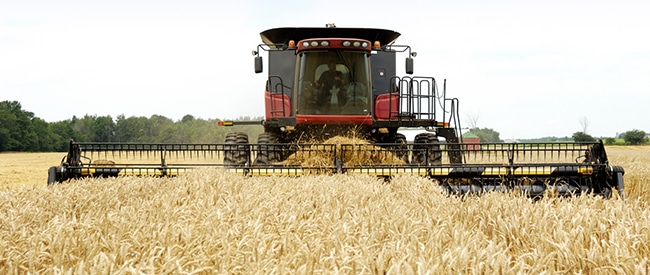Risk Management on the Farm: Grain

Risk management on the farm helps protect everyone. This five-part series introduces various safety challenges on different types of farms, check out Part 1: Poultry; Part 2: Dairy; Part 3: Ranch; and Part 5: Fruit and Berry.
With acres upon acres of canola or lentils or durum (and so many other grain, legume, and oilseed crops), there are plenty of tasks to keep a grain farmer busy during the day. Ensuring a proper grain risk management program is in place will help protect all aspects of the operation.
Machinery
In order to manage so much land, farmers must make use of machinery: tractors, combines, cultivators, sprayers, fans, augers, grain dryers, and conveyors. Plus, as technology advances, many of these machines may operate with partial or complete artificial intelligence. Protecting your machinery and the people that operate them is important and can be accomplished with a few suggestions to optimize safety.
- Always give a wide berth when walking around operating machinery
- Give staff regular training for how to operate farm machinery
- Follow all manufacturer’s directions for maintaining machinery
- Keep a record of all regular maintenance completed on machinery such as oil changes, repairs to tires or belt changes
- Store machinery under cover to protect it from the elements, where possible
- Add a fire extinguisher to each machine
- Wear the right attire for the job i.e. tie back long hair, tie shoelaces, tuck in shirt
- Be alert when operating machinery, this means paying attention and avoiding consumption of any substance that may impair you
- Wait for machinery to completely stop before touching it
- Keep children and pets away from machinery
Harvest
Watching a crop grow from a field of newly turned, brown earth to a plant holds a certain kind of magic. As a crop gets close to harvest it must be monitored daily, then there’s often a rush to harvest at peak maturity—before conditions change and quality is lost. With a good grain risk management plan, you can confidently proceed through harvest knowing you are prepared and ready should an unexpected event come up.
- Clear fields of large debris that may seize machinery during harvest i.e. rocks
- Regularly monitor crops for pests and rot
- Try to get some rest, when the crop is ready, it usually must be harvested quickly and getting enough rest will ensure you are in top shape for the work at hand
- Should machinery fail, have a contingency plan to continue harvesting i.e. loss of use insurance or a neighbour to call on
Bins and Silos
Once produce is harvested, it is important to store safely until it’s ready to be sold. Grain bins and silos are the storage of choice for many farmers. No matter how large or small, bins and silos have specialized safety precautions to protect workers.
- Before installing bins, hire a qualified geotechnical engineer to inspect your selected site and confirm it is suitable for the number of bins and size of bins you need
- Anchor all bins to prevent tipping
- Ensure bins are located on a concrete pad
- Ensure bins are completely sealed
- Practice pest management practices
- When entering a bin, keep in mind
- Small spaces like grain bins are at risk for toxic gases like hydrogen sulfide or carbon monoxide, wear a gas detector that can notify you of danger
- Always use fall and lifeline protection when entering a bin
Maintenance
Regular and scheduled maintenance can help keep a farm running smoothly. Keep in mind the following aspects of your farm when drafting the maintenance schedule of your grain risk management plan:
- All buildings
- All electrical installations
- Silos
- Bins
- Fuel tanks
- Drainage and irrigation systems
- Roads
Reach out to your insurance broker to learn more about your farm insurance policy and how it may protect you in the event of a loss.

